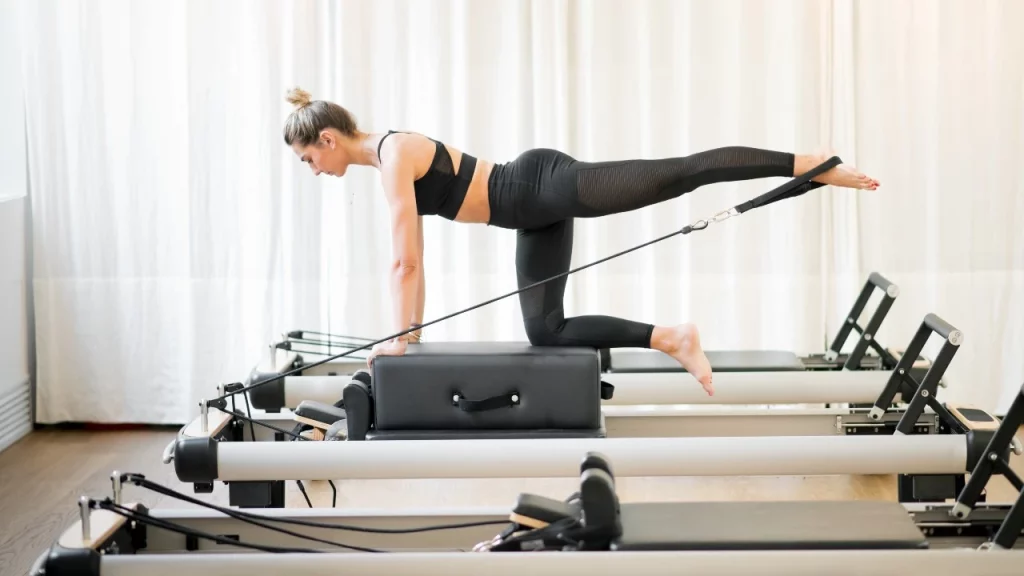Regular Pilates exercises might be good for your back, but if you have bad days or injuries, using a reformer can help. Read about the advantages of using a reformer in this blog article.
What is a Pilates Reformer?
A Pilates reformer is a type of reformer machine that targets the muscles of the core and lower body. It’s been used in Pilates classes for many years, but it’s become more popular recently as a way to get more out of Pilates exercises.
Pilates reformer helps you work all your core muscles (including the transverse abdominis, rectus abdominis, internal and external obliques, and pelvic floor) in a way that doesn’t require you to use your hands. Plus, because they’re adjustable to fit different heights and body types, you can tailor your workouts to focus on specific areas or muscle groups.
Reformer machines are also great for people who are new to Pilates. They make it easy to do basic Pilates moves without feeling too intimidated or overwhelmed. Plus, since you can control how much resistance the machine provides, you can fine-tune your workout to target specific areas or muscle groups.
Parts of A Pilates Reformer
A Pilates reformer is a specially designed machine that provides the perfect foundation for Pilates exercises. The reformer has adjustable springs and supports your body in a variety of ways, allowing you to target specific muscles and achieve deeper stretching.
The Pilates reformer also removes friction from the floor, which makes the experience more comfortable and helps reduce injury risk. Plus, the reformer’s height allows you to work at a lower level of intensity than on a traditional Pilates-style apparatus, which is great if you’re just starting out or if you have limited mobility.
How to Use a Pilates Reformer?
If you’re thinking about adding Pilates to your workout routine, you might be wondering how to use a Pilates reformer. Here are three tips for getting started:
- Get Comfortable on the Reformer
The first step is to get comfortable with the reformer. You’ll want to adjust the seat and footrests so that they’re comfortable for you. Once you’re comfortable, start by performing basic exercises like circles and forward bends.
- Add Some Supine Positions
Once you’ve gotten comfortable on the reformer, it’s time to add some supine positions. This means lying down on your back or side. Supine poses can help improve your flexibility and balance, both of which are important for Pilates exercises. Try practicing simple stretches like cat-cows or pigeon pose before doing more challenging poses like eagle pose or cobra pose.
Benefits of Pilates Exercises
Strengthening your core is a key part of a healthy body. Pilates exercises help to create stability in the abdominal, pelvic and lower back muscles, which can improve posture and overall health.
Pilates exercises can also help to improve breathing, circulation, and balance. They are an excellent way to reduce stress and tension in the body, which can lead to better mental health. Pilates exercises are also good for people who have difficulty with other forms of exercise because they often use fewer repetitions than other types of exercise.
Popular Pilates Exercises
Pilates is a great fitness routine for people of all ages. It is a gentle, body-mind exercise that can help improve your flexibility, strength, balance, and circulation. Pilates exercises are also very popular with pregnant women as it helps to prevent preterm labor and postpartum syndrome.
There are a variety of Pilates exercises you can do on the reformer, including:
1) The plié: This exercise works the lower body and core muscles. Lie down on your back on the reformer with your knees bent and feet flat on the floor. Place your hands behind your head and lift your chest off the ground while keeping your back straight. Hold this position for two seconds then release and repeat.
2) The bow pose: This Pilates exercise strengthens the abdominal muscles and opens up the hips. Lie down on your stomach with both arms stretched out in front of you, palms down. Lift your upper torso off the ground by pushing through your hands and legs until you’re in a seated position with your legs together. Keep your abdominal pulled in towards your spine throughout the exercise. Hold for two seconds then release and repeat five times.
3) The Child’s Pose: This Pilates exercise tones the lower body and improves blood flow to the pelvic area. Position yourself on all fours with palms flat on the floor beside you, shoulder-width apart.
Conclusion
Pilates exercises can be a great way to tone your body, improve your flexibility, and increase your overall strength. However, many people are scared to try Pilates because they don’t know how to use a reformer safely. In this article, we will teach you the basics of using a reformer so that you can start incorporating these amazing exercises into your routine. Make sure to read through the entire article before starting so that you have a better understanding of what you’re getting yourself into!

